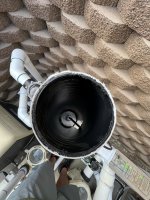- Jan 24, 2020
- 231
- Pool Size
- 29000
- Surface
- Plaster
- Chlorine
- Salt Water Generator
- SWG Type
- Pentair Intellichlor IC-60


Yah, I think that would work great. And probably look nicest.Mine is also down low and relatively well protected similar to @Dirk has. Not sure what you could use to protect it. Maybe you could slot and notch a piece of larger PVC pipe (3"?) to fit over the top of it and extend down over the 2" pipe to keep it in place? Let me know if that doesn't make sense and I can sketch what I'm thinking.
--Jeff
So when you have any sort of closed valve (like an auto-filler valve) downstream of the type of anti-siphon valve you have on your pad, the pipe leaving that anti-siphon valve is under constant, full pressure, as is the anti-siphon components within the valve. Those components are rated for uses like running sprinklers, where the pressure is no where near full blast, and only then when you're running sprinklers: not full time. Those components are not rated for constant, full pressure, and will eventually fail because of it. And because those types of valves are not testable, you might not ever realize it has failed, and that it no longer is pulling its anti-siphon duty. That duty is meant to protect your water supply from being contaminated by pool water and its nasty chemicals. You should have a pressure-rated backflow preventer for the job. Like this one:and yes that anti siphon valve sends water to a auto fill with float next to my pool. Let me know what you wanted to share.
Thanks. I’m trying to figure out how i should re-plumb this setup. I also have a double check valve setup to add to the main line that the pool and irrigation are all on too.So when you have any sort of closed valve (like an auto-filler valve) downstream of the type of anti-siphon valve you have on your pad, the pipe leaving that anti-siphon valve is under constant, full pressure, as is the anti-siphon components within the valve. Those components are rated for uses like running sprinklers, where the pressure is no where near full blast, and only then when you're running sprinklers: not full time. Those components are not rated for constant, full pressure, and will eventually fail because of it. And because those types of valves are not testable, you might not ever realize it has failed, and that it no longer is pulling its anti-siphon duty. That duty is meant to protect your water supply from being contaminated by pool water and its nasty chemicals. You should have a pressure-rated backflow preventer for the job. Like this one:
You can read more about it here:
Back Flow Preventer - Further Reading
www.troublefreepool.com
Maybe you can use some of this. It's a crazy long thread. This link jumps to the plumbing part:Thanks. I’m trying to figure out how i should re-plumb this setup. I also have a double check valve setup to add to the main line that the pool and irrigation are all on too.
Jeff what is your sketch idea. Like a Viking helmet the slides down over ?Mine is also down low and relatively well protected similar to @Dirk has. Not sure what you could use to protect it. Maybe you could slot and notch a piece of larger PVC pipe (3"?) to fit over the top of it and extend down over the 2" pipe to keep it in place? Let me know if that doesn't make sense and I can sketch what I'm thinking.
--Jeff

If the tolerance is that close (it's only 1/8" on all sides), you might not even need to make the slots. It might stand up just fine slipping a length of 3" pipe over the upward-facing port of the 2" tee...According to the google machine:
Outside diameter of a PVC tee port is about 2.75".
Inside diameter of a 3" PVC pipe is about 3.04".
Sometimes the big box stores have a selection of PVC in 2' lengths.
I'd still consider making the slots. The concern is an object striking it, such as a ball. If you can give it more vertical depth it may provide more lateral stability and distribute any loads from an inadvertent ball strike to the entire tee, and not just the branch portion.If the tolerance is that close (it's only 1/8" on all sides), you might not even need to make the slots. It might stand up just fine slipping a length of 3" pipe over the upward-facing port of the 2" tee...

Sounds right.If you can give it more vertical depth it may provide more lateral stability










